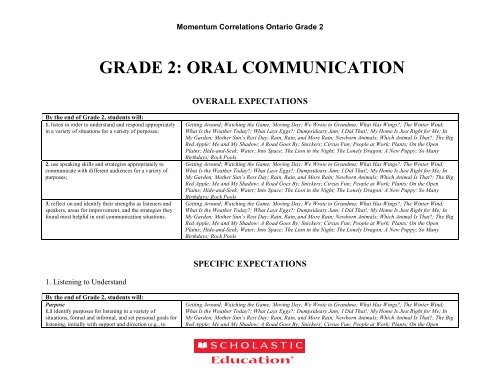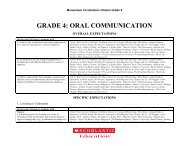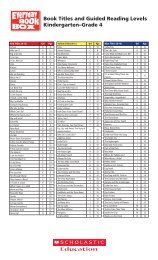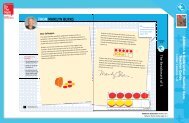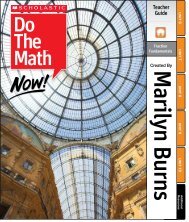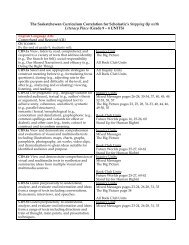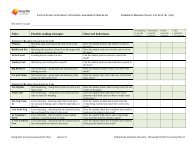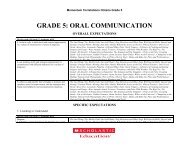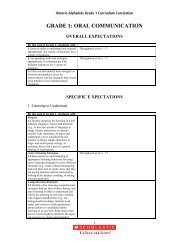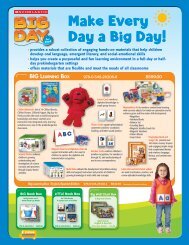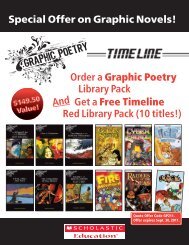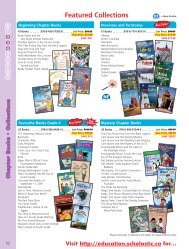GRADE 2: ORAL COMMUNICATION - Scholastic Education
GRADE 2: ORAL COMMUNICATION - Scholastic Education
GRADE 2: ORAL COMMUNICATION - Scholastic Education
You also want an ePaper? Increase the reach of your titles
YUMPU automatically turns print PDFs into web optimized ePapers that Google loves.
Momentum Correlations Ontario Grade 2Visual Aids2.7 use a few different visual aids, (e.g., photographs,artefacts, a story map) to support or enhance oralpresentations (e.g., use a family photograph as part of anoral recount of an event; use a story map to retell a story)Getting Around; Dumpsideary Jam; In My Garden; Which Animal Is That?; People at Work; On the Open Plains;The Lion in the Night3. Reflecting on Oral Communication Skills and StrategiesBy the end of Grade 2, students will:Metacognition3.1 identify, initially with support and direction, a fewstrategies they found helpful before, during, and afterlistening and speakingTeacher prompts: “What questions can you ask yourselfwhile listening to be sure that you understand what youhear?” “What can you do after listening to check that youhave understood?” “How do you get ready to speak?”“While you are speaking, how do you check whether youare keeping the attention of your audience?”Interconnected Skills3.2 identify, initially with support and direction, how theirskills as viewers, representers, readers, and writers helpthem improve their oral communication skillsTeacher prompts: “How does listening make you a betterspeaker?” “How does viewing texts help you when youare listening?”Getting Around; Watching the Game; Moving Day; We Wrote to Grandma; What Has Wings?; The Winter Wind;What Is the Weather Today?; What Lays Eggs?; Dumpsideary Jam; I Did That!; My Home Is Just Right for Me; InMy Garden; Mother Sun’s Rest Day; Rain, Rain, and More Rain; Newborn Animals; Which Animal Is That?; The BigRed Apple; Me and My Shadow; A Road Goes By; Snickers; Circus Fun; People at Work; Plants; On the OpenPlains; Hide-and-Seek; Water; Into Space; The Lion in the Night; The Lonely Dragon; A New Puppy; So ManyBirthdays; Rock PoolsGetting Around; Watching the Game; Moving Day; We Wrote to Grandma; What Has Wings?; The Winter Wind;What Is the Weather Today?; What Lays Eggs?; Dumpsideary Jam; I Did That!; My Home Is Just Right for Me; InMy Garden; Mother Sun’s Rest Day; Rain, Rain, and More Rain; Newborn Animals; Which Animal Is That?; The BigRed Apple; Me and My Shadow; A Road Goes By; Snickers; Circus Fun; People at Work; Plants; On the OpenPlains; Hide-and-Seek; Water; Into Space; The Lion in the Night; The Lonely Dragon; A New Puppy; So ManyBirthdays; Rock Pools
Momentum Correlations Ontario Grade 2simple text forms, with a focus on literary texts such as afairy tale (e.g., plot, characters, setting), graphic textssuch as a primary dictionary (e.g., words listed inalphabetical order, simple definitions accompanied bypicture clues or diagrams), and informational texts such asa “How to” book (e.g., materials listed in order of use,numbered steps, labels, diagrams)Text Patterns2.2 recognize simple organizational patterns in texts ofdifferent types, and explain, initially with support anddirection, how the patterns help readers understand thetexts (e.g., numbered steps help the reader follow aprocedure or set of instructions correctly)Text Features2.3 identify some text features and explain how they helpreaders understand texts (e.g., table of contents, index,chart, illustrations, pictures, diagrams, icons)Teacher prompt: “How does the diagram help youunderstand the explanation?”Elements of Style2.4 identify some simple elements of style, includingvoice, word choice, and different types of sentences, andexplain how they help readers understand texts (e.g.,descriptive adjectives help the reader visualize a setting;alliteration helps make ideas or characters stand out: redred robin)My Garden; Mother Sun’s Rest Day; Rain, Rain, and More Rain; Newborn Animals; Which Animal Is That?; The BigRed Apple; Me and My Shadow; A Road Goes By; Snickers; Circus Fun; People at Work; Plants; On the OpenPlains; Hide-and-Seek; Water; Into Space; The Lion in the Night; The Lonely Dragon; A New Puppy; So ManyBirthdays; Rock PoolsGetting Around; We Wrote to Grandma; What Has Wings?; What Is the Weather Today?; I Did That!; Mother Sun’sRest Day; Snickers; Hide-and-SeekGetting Around; Watching the Game; Moving Day; We Wrote to Grandma; What Has Wings?; The Winter Wind;What Is the Weather Today?; What Lays Eggs?; Dumpsideary Jam; I Did That!; My Home Is Just Right for Me; InMy Garden; Mother Sun’s Rest Day; Rain, Rain, and More Rain; Newborn Animals; Which Animal Is That?; The BigRed Apple; Me and My Shadow; A Road Goes By; Snickers; Circus Fun; People at Work; Plants; On the OpenPlains; Hide-and-Seek; Water; Into Space; The Lion in the Night; The Lonely Dragon; A New Puppy; So ManyBirthdays; Rock PoolsGetting Around; Watching the Game; Moving Day; We Wrote to Grandma; What Has Wings?; The Winter Wind;What Is the Weather Today?; What Lays Eggs?; Dumpsideary Jam; I Did That!; My Home Is Just Right for Me; InMy Garden; Mother Sun’s Rest Day; Rain, Rain, and More Rain; Newborn Animals; Which Animal Is That?; The BigRed Apple; Me and My Shadow; A Road Goes By; Snickers; Circus Fun; People at Work; Plants; On the OpenPlains; Hide-and-Seek; Water; Into Space; The Lion in the Night; The Lonely Dragon; A New Puppy; So ManyBirthdays; Rock Pools3. Reading With FluencyBy the end of Grade 2, students will:Reading Familiar Words3.1 automatically read and understand many highfrequencywords, some words with common spellingpatterns, and words of personal interest or significance, ina variety of reading contexts (e.g., the same word indifferent graphic representations such as: on charts orposters; in shared-, guided-, and independent-readingtexts; in shared- and interactive-writing texts; in personalwriting and the writing of their peers)Getting Around; Watching the Game; Moving Day; We Wrote to Grandma; What Has Wings?; The Winter Wind;What Is the Weather Today?; What Lays Eggs?; Dumpsideary Jam; I Did That!; My Home Is Just Right for Me; InMy Garden; Mother Sun’s Rest Day; Rain, Rain, and More Rain; Newborn Animals; Which Animal Is That?; The BigRed Apple; Me and My Shadow; A Road Goes By; Snickers; Circus Fun; People at Work; Plants; On the OpenPlains; Hide-and-Seek; Water; Into Space; The Lion in the Night; The Lonely Dragon; A New Puppy; So ManyBirthdays; Rock Pools
Momentum Correlations Ontario Grade 2Reading Unfamiliar Words3.2 predict the meaning of and quickly solve unfamiliarwords using different types of cues, including:• semantic (meaning) cues (e.g., familiar words, phrases,sentences, and visuals that activate existing knowledge oforal and written language);• syntactic (language structure) cues (e.g., word order,language patterns, punctuation);• graphophonic (phonological and graphic) cues (e.g.,letter clusters within words; onset and rime; commonspelling patterns; words within words; visual features ofwords such as shape or size)Teacher prompt (for cross-checking of cues): “The worddoes have the same beginning sound (bright and brought)but does it make sense in this sentence?”Reading Fluently3.3 read appropriate texts at a sufficient rate and withsufficient expression to convey the sense of the text to thereader and to an audience (e.g., make oral reading soundlike spoken language, with the appropriate pauses, stops,and starts indicated by the punctuation)Moving Day; We Wrote to Grandma; The Winter Wind; What Lays Eggs?; In My Garden; Mother Sun’s Rest Day;Rain, Rain, and More Rain; Which Animal Is That?; The Big Red Apple; Me and My Shadow; A Road Goes By;Snickers; Circus Fun; People at Work; Plants; On the Open Plains; Hide-and-Seek; Water; Into Space; The Lion inthe Night; The Lonely Dragon; A New Puppy; So Many Birthdays; Rock PoolsGetting Around; Watching the Game; Moving Day; We Wrote to Grandma; What Has Wings?; The Winter Wind;What Is the Weather Today?; What Lays Eggs?; Dumpsideary Jam; I Did That!; My Home Is Just Right for Me; InMy Garden; Mother Sun’s Rest Day; Rain, Rain, and More Rain; Newborn Animals; Which Animal Is That?; The BigRed Apple; Me and My Shadow; A Road Goes By; Snickers; Circus Fun; People at Work; Plants; On the OpenPlains; Hide-and-Seek; Water; Into Space; The Lion in the Night; The Lonely Dragon; A New Puppy; So ManyBirthdays; Rock PoolsTeacher prompt: “Can you make your reading sound justas if you are talking?”4. Reflecting on Reading Skills and StrategiesBy the end of Grade 2, students will:Metacognition4.1 identify, initially with support and direction, a fewstrategies that they found helpful before, during, and afterreadingTeacher prompts: “What questions do you ask yourself tocheck and see whether you understand what you arereading? What do you do if you don't understand?”“When you come to a word or phrase you don't know,what strategies do you use to solve it? How do you checkto see if you were right?”Getting Around; Watching the Game; Moving Day; We Wrote to Grandma; What Has Wings?; The Winter Wind;What Is the Weather Today?; What Lays Eggs?; Dumpsideary Jam; I Did That!; My Home Is Just Right for Me; InMy Garden; Mother Sun’s Rest Day; Rain, Rain, and More Rain; Newborn Animals; Which Animal Is That?; The BigRed Apple; Me and My Shadow; A Road Goes By; Snickers; Circus Fun; People at Work; Plants; On the OpenPlains; Hide-and-Seek; Water; Into Space; The Lion in the Night; The Lonely Dragon; A New Puppy; So ManyBirthdays; Rock Pools
Momentum Correlations Ontario Grade 2Interconnected Skills4.2 explain, initially with support and direction, how theirskills in listening, speaking, writing, viewing, andrepresenting help them make sense of what they read(e.g., reading a text independently is easier afterdiscussing the topic with a partner and/or talking about itin a group)Getting Around; Watching the Game; Moving Day; We Wrote to Grandma; What Has Wings?; The Winter Wind;What Is the Weather Today?; What Lays Eggs?; Dumpsideary Jam; I Did That!; My Home Is Just Right for Me; InMy Garden; Mother Sun’s Rest Day; Rain, Rain, and More Rain; Newborn Animals; Which Animal Is That?; The BigRed Apple; Me and My Shadow; A Road Goes By; Snickers; Circus Fun; People at Work; Plants; On the OpenPlains; Hide-and-Seek; Water; Into Space; The Lion in the Night; The Lonely Dragon; A New Puppy; So ManyBirthdays; Rock PoolsTeacher prompt: “How do discussions before readinghelp you get ready to read about new topics?”
Momentum Correlations Ontario Grade 2<strong>GRADE</strong> 2: WRITINGOVERALL EXPECTATIONSBy the end of Grade 2, students will:1. generate, gather, and organize ideas and information towrite for an intended purpose and audience;2. draft and revise their writing, using a variety ofinformational, literary, and graphic forms and stylisticelements appropriate for the purpose and audience;3. use editing, proofreading, and publishing skills andstrategies, and knowledge of language conventions, tocorrect errors, refine expression, and present their workeffectively;4. reflect on and identify their strengths as writers, areasfor improvement, and the strategies they found mosthelpful at different stages in the writing process.Getting Around; Watching the Game; Moving Day; We Wrote to Grandma; What Has Wings?; The Winter Wind;What Is the Weather Today?; What Lays Eggs?; Dumpsideary Jam; I Did That!; My Home Is Just Right for Me; InMy Garden; Mother Sun’s Rest Day; Rain, Rain, and More Rain; Newborn Animals; Which Animal Is That?; The BigRed Apple; Me and My Shadow; A Road Goes By; Snickers; Circus Fun; People at Work; Plants; On the OpenPlains; Hide-and-Seek; Water; Into Space; The Lion in the Night; The Lonely Dragon; A New Puppy; So ManyBirthdays; Rock PoolsGetting Around; Watching the Game; Moving Day; We Wrote to Grandma; What Has Wings?; The Winter Wind;What Is the Weather Today?; What Lays Eggs?; Dumpsideary Jam; I Did That!; My Home Is Just Right for Me; InMy Garden; Mother Sun’s Rest Day; Rain, Rain, and More Rain; Newborn Animals; Which Animal Is That?; The BigRed Apple; Me and My Shadow; A Road Goes By; Snickers; Circus Fun; People at Work; Plants; On the OpenPlains; Hide-and-Seek; Water; Into Space; The Lion in the Night; The Lonely Dragon; A New Puppy; So ManyBirthdays; Rock PoolsGetting Around; Watching the Game; Moving Day; We Wrote to Grandma; What Has Wings?; The Winter Wind;What Is the Weather Today?; What Lays Eggs?; Dumpsideary Jam; I Did That!; My Home Is Just Right for Me; InMy Garden; Mother Sun’s Rest Day; Rain, Rain, and More Rain; Newborn Animals; Which Animal Is That?; The BigRed Apple; Me and My Shadow; A Road Goes By; Snickers; Circus Fun; People at Work; Plants; On the OpenPlains; Hide-and-Seek; Water; Into Space; The Lion in the Night; The Lonely Dragon; A New Puppy; So ManyBirthdays; Rock PoolsGetting Around; Watching the Game; Moving Day; We Wrote to Grandma; What Has Wings?; The Winter Wind;What Is the Weather Today?; What Lays Eggs?; Dumpsideary Jam; I Did That!; My Home Is Just Right for Me; InMy Garden; Mother Sun’s Rest Day; Rain, Rain, and More Rain; Newborn Animals; Which Animal Is That?; The BigRed Apple; Me and My Shadow; A Road Goes By; Snickers; Circus Fun; People at Work; Plants; On the OpenPlains; Hide-and-Seek; Water; Into Space; The Lion in the Night; The Lonely Dragon; A New Puppy; So ManyBirthdays; Rock PoolsSPECIFIC EXPECTATIONS1. Developing and Organizing Content
Momentum Correlations Ontario Grade 2By the end of Grade 2, students will:Purpose and Audience1.1 identify the topic, purpose, audience, and form forwriting (e.g., a fairy tale to entertain another class; theprocedure for fire drills to inform the class; a poster topromote a favourite book or movie)Teacher prompts: “What is your writing about?” “Whyare you writing?” “Whom are you writing for?”Developing Ideas1.2 generate ideas about a potential topic, using a varietyof strategies and resources (e.g., formulate and askquestions such as the five W's [who, what, when, where,why] to identify personal experiences, prior knowledge,and information needs; brainstorm ideas with a partner)Research1.3 gather information to support ideas for writing in avariety of ways and/or from a variety of sources (e.g.,from discussions with family and friends; from a varietyof texts, including teacher read-alouds, mentor texts,shared-, guided-, and independent-reading texts, andmedia texts)Classifying Ideas1.4 sort ideas and information for their writing in a varietyof ways, with support and direction (e.g., by using simplegraphic organizers such as webs or a Venn diagram)Organizing Ideas1.5 identify and order main ideas and supporting details,using graphic organizers (e.g., a story grammar:characters, setting, problem, solution; a sequential chart:first, then, next, finally) and organizational patterns (e.g.,problem-solution, chronological order)Review1.6 determine whether the ideas and information theyhave gathered are suitable for the purpose, and gather newmaterial if necessary (e.g., use a graphic organizer toexplain their material to a classmate and ask for feedbackto identify gaps)Getting Around; Watching the Game; Moving Day; We Wrote to Grandma; What Has Wings?; The Winter Wind;What Is the Weather Today?; What Lays Eggs?; Dumpsideary Jam; I Did That!; My Home Is Just Right for Me; InMy Garden; Mother Sun’s Rest Day; Rain, Rain, and More Rain; Newborn Animals; Which Animal Is That?; The BigRed Apple; Me and My Shadow; A Road Goes By; Snickers; Circus Fun; People at Work; Plants; On the OpenPlains; Hide-and-Seek; Water; Into Space; The Lion in the Night; The Lonely Dragon; A New Puppy; So ManyBirthdays; Rock PoolsGetting Around; Watching the Game; Moving Day; We Wrote to Grandma; What Has Wings?; The Winter Wind;What Is the Weather Today?; What Lays Eggs?; Dumpsideary Jam; I Did That!; My Home Is Just Right for Me; InMy Garden; Mother Sun’s Rest Day; Rain, Rain, and More Rain; Newborn Animals; Which Animal Is That?; The BigRed Apple; Me and My Shadow; A Road Goes By; Snickers; Circus Fun; People at Work; Plants; On the OpenPlains; Hide-and-Seek; Water; Into Space; The Lion in the Night; The Lonely Dragon; A New Puppy; So ManyBirthdays; Rock PoolsGetting Around; Watching the Game; Moving Day; We Wrote to Grandma; What Has Wings?; The Winter Wind;What Is the Weather Today?; What Lays Eggs?; Dumpsideary Jam; I Did That!; My Home Is Just Right for Me; InMy Garden; Mother Sun’s Rest Day; Rain, Rain, and More Rain; Newborn Animals; Which Animal Is That?; The BigRed Apple; Me and My Shadow; A Road Goes By; Snickers; Circus Fun; People at Work; Plants; On the OpenPlains; Hide-and-Seek; Water; Into Space; The Lion in the Night; The Lonely Dragon; A New Puppy; So ManyBirthdays; Rock PoolsGetting Around; Watching the Game; My Home Is Just Right for Me; In My Garden; Mother Sun’s Rest Day;Newborn Animals; Me and My Shadow; A Road Goes By; Snickers; People at Work; Plants; On the Open Plains;Hide-and-Seek; Water; Into Space; The Lion in the Night; A New Puppy; Rock PoolsWatching the Game; We Wrote to Grandma; What Lays Eggs?; Dumpsideary Jam; I Did That!; In My Garden;Mother Sun’s Rest Day; Newborn Animals; The Big Red Apple; A Road Goes By; Snickers; Circus Fun; Plants; Onthe Open Plains; Hide-and-Seek; The Lonely Dragon; So Many BirthdayMoving Day; What Has Wings?; Rain, Rain, and More Rain; A Road Goes By2. Using Knowledge of Form and Style in Writing
Momentum Correlations Ontario Grade 2By the end of Grade 2, students will:Form2.1 write short texts using several simple forms (e.g., afriendly letter; a factual recount of a scientific ormathematical investigation; a recipe describing theprocedure for cooking a favourite food; directions forplaying a game; a paragraph describing the physicalcharacteristics of an animal; an original story or anextension of a familiar story, modelled on stories read;their own variation on a patterned poem; an advertisementfor a toy)Voice2.2 establish a personal voice in their writing, with a focuson using familiar words that convey their attitude orfeeling towards the subject or audience (e.g., words thatconvey admiration for a character: a cool person)Word Choice2.3 use familiar words and phrases to communicaterelevant details (e.g., a sequence of adjectives: The big,brown bear...)Sentence Fluency2.4 use a variety of sentence types (e.g., questions,statements, exclamations)Point of View2.5 identify, initially with support and direction, theirpoint of view and one or more possible different points ofview about the topicGetting Around; Watching the Game; Moving Day; We Wrote to Grandma; What Has Wings?; The Winter Wind;What Is the Weather Today?; What Lays Eggs?; Dumpsideary Jam; I Did That!; My Home Is Just Right for Me; InMy Garden; Mother Sun’s Rest Day; Rain, Rain, and More Rain; Newborn Animals; Which Animal Is That?; The BigRed Apple; Me and My Shadow; A Road Goes By; Snickers; Circus Fun; People at Work; Plants; On the OpenPlains; Hide-and-Seek; Water; Into Space; The Lion in the Night; The Lonely Dragon; A New Puppy; So ManyBirthdays; Rock PoolsGetting Around; Watching the Game; Moving Day; We Wrote to Grandma; What Has Wings?; The Winter Wind;What Is the Weather Today?; What Lays Eggs?; Dumpsideary Jam; I Did That!; My Home Is Just Right for Me; InMy Garden; Mother Sun’s Rest Day; Rain, Rain, and More Rain; Newborn Animals; Which Animal Is That?; The BigRed Apple; Me and My Shadow; A Road Goes By; Snickers; Circus Fun; People at Work; Plants; On the OpenPlains; Hide-and-Seek; Water; Into Space; The Lion in the Night; The Lonely Dragon; A New Puppy; So ManyBirthdays; Rock PoolsGetting Around; Watching the Game; Moving Day; We Wrote to Grandma; What Has Wings?; The Winter Wind;What Is the Weather Today?; What Lays Eggs?; Dumpsideary Jam; I Did That!; My Home Is Just Right for Me; InMy Garden; Mother Sun’s Rest Day; Rain, Rain, and More Rain; Newborn Animals; Which Animal Is That?; The BigRed Apple; Me and My Shadow; A Road Goes By; Snickers; Circus Fun; People at Work; Plants; On the OpenPlains; Hide-and-Seek; Water; Into Space; The Lion in the Night; The Lonely Dragon; A New Puppy; So ManyBirthdays; Rock PoolsGetting Around; Watching the Game; Moving Day; We Wrote to Grandma; What Has Wings?; The Winter Wind;What Is the Weather Today?; What Lays Eggs?; Dumspideary Jam; I Did That!; My Home Is Just Right for Me; InMy Garden; Mother Sun’s Rest Day; Rain, Rain, and More Rain; Newborn Animals; Which Animal Is That?; The BigRed Apple; Me and My Shadow; A Road Goes By; Snickers; Circus Fun; People at Work; Plants; On the OpenPlains; Hide-and-Seek; Water; Into Space; The Lion in the Night; The Lonely Dragon; A New Puppy; So ManyBirthdays; Rock PoolsWe Wrote to Grandma; What Is the Weather Today?; I Did That!; Rain, Rain, and More Rain; People at Work;Water; A New PuppyTeacher prompt: “How do you feel about this topic? Howdo you think other people - such as children from adifferent country or grandparents - might feel about thistopic? How will you share these feelings in yourwriting?”
Momentum Correlations Ontario Grade 2Preparing for Revision2.6 identify elements of their writing that needimprovement, using feedback from the teacher and peers,with a focus on content and word choiceTeacher prompts: “Do you have enough information tosupport your ideas?” “Are there any other words that youcould use to create a better word picture for youraudience?”Revision2.7 make simple revisions to improve the content, clarity,and interest of their written work, using several types ofstrategies (e.g., reordering sentences to presentinformation in a more logical sequence; adding linkingwords to connect ideas; replacing general words withconcrete, specific words/phrases)Teacher prompt: “What linking words could you use toconnect two ideas?” “What words could you add to createa more vivid picture for the reader?”Producing Drafts2.8 produce revised, draft pieces of writing to meetcriteria identified by the teacher, based on theexpectationsWatching the Game; Moving Day; We Wrote to Grandma; What Has Wings?; Dumpsideary Jam; I Did That!; MyHome Is Just Right for Me; Mother Sun’s Rest Day; Rain, Rain, and More Rain; Me and My Shadow; Snickers;Circus Fun; People at Work; On the Open Plains; Into Space; The Lion in the Night; The Lonely DragonWatching the Game; Moving Day; We Wrote to Grandma; What Has Wings?; Dumpsideary Jam; I Did That!; MyHome Is Just Right for Me; Mother Sun’s Rest Day; Rain, Rain, and More Rain; Me and My Shadow; Snickers;Circus Fun; People at Work; On the Open Plains; Into Space; The Lion in the Night; The Lonely DragonWatching the Game; We Wrote to Grandma; The Winter Wind; Mother Sun’s Rest Day; Me and My Shadow; TheLion in the Night3. Applying Knowledge of Language Conventions and Presenting Written Work EffectivelyBy the end of Grade 2, students will:Spelling Familiar Words3.1 spell many high-frequency words correctly (e.g.,words from their oral vocabulary, anchor charts, the classword wall, and shared-, guided-, and independent-readingtexts)Spelling Unfamiliar Words3.2 spell unfamiliar words using a variety of strategiesthat involve understanding sound-symbol relationships,word structures, word meanings, and generalizationsabout spelling (e.g., spell words out loud; segment wordsinto clusters of letters to hear onset and rime; sort wordsGetting Around; Watching the Game; Moving Day; We Wrote to Grandma; What Has Wings?; The Winter Wind;What Is the Weather Today?; What Lays Eggs?; Dumpsideary Jam; I Did That!; My Home Is Just Right for Me; InMy Garden; Mother Sun’s Rest Day; Rain, Rain, and More Rain; Newborn Animals; Which Animal Is That?; The BigRed Apple; Me and My Shadow; A Road Goes By; Snickers; Circus Fun; People at Work; Plants; On the OpenPlains; Hide-and-Seek; Water; Into Space; The Lion in the Night; The Lonely Dragon; A New Puppy; So ManyBirthdays; Rock PoolsGetting Around; Watching the Game; Moving Day; We Wrote to Grandma; The Winter Wind; I Did That!; In MyGarden; Mother Sun’s Rest Day; Rain, Rain, and More Rain; Newborn Animals; Which Animal Is That?; The BigRed Apple; Me and My Shadow; Snickers; People at Work; Plants; On the Open Plains; Hide-and-Seek; Water; IntoSpace; The Lion in the Night; The Lonely Dragon; A New Puppy; So Many Birthdays; Rock Pools
Momentum Correlations Ontario Grade 2by common sound patterns and/or letter sequences; linkletters to words: You hear with your ear; follow rules foradding endings to base words when the spelling doesn'tchange; use word meanings to help spell simplecontractions and homophones: bear/bare)Vocabulary3.3 confirm spellings and word meanings or word choiceusing a few different types of resources (e.g., locate wordsin alphabetical order by using first and second letters in aprimary dictionary, on a word wall, or in an online picturedictionary)Punctuation3.4 use punctuation to help communicate their intendedmeaning, with a focus on the use of: question marks,periods, or exclamation marks at the end of a sentence;commas to mark pauses; and some uses of quotationmarksGrammar3.5 use parts of speech appropriately to communicatetheir meaning clearly, with a focus on the use of: propernouns for local, provincial, and national place names andfor holidays; the personal object pronouns me, you, him,her, us, them; adjectives to describe a noun; verbs in thesimple present and past tenses; joining words (e.g., and,but); simple prepositions of place and time (e.g., under,with, before, after)Proofreading3.6 proofread and correct their writing using a simplechecklist or a few guiding questions developed with theteacher and posted for reference (e.g., Does each sentencemake sense? Are the ideas and information presented in alogical order? Does each sentence begin with a capitalletter and end with a period, question mark, orexclamation mark? What resources can I use to check thespelling of a word if it doesn't look right?)Publishing3.7 use some appropriate elements of effectivepresentation in the finished product, including print,different fonts, graphics, and layout (e.g., use legibleprinting, spacing, margins, varied print size, and colourfor emphasis; include a simple labelled diagram in aWhat Has Wings?; The Winter Wind; I Did That!; Mother Sun’s Rest Day; Rain, Rain, and More Rain; NewbornAnimals; Circus Fun; On the Open Plains; Water; The Lion in the Night; The Lonely Dragon; A New Puppy; SoMany BirthdaysGetting Around; Watching the Game; Moving Day; We Wrote to Grandma; The Winter Wind; What Is the WeatherToday?; Dumpsideary Jam; I Did That!; My Home Is Just Right for Me; In My Garden; Mother Sun’s Rest Day;Newborn Animals; Which Animal Is That?; The Big Red Apple; Snickers; People at Work; Plants; The Lion in theNight; The Lonely Dragon; Rock PoolsGetting Around; Watching the Game; Moving Day; We Wrote to Grandma; What Has Wings?; The Winter Wind;What Is the Weather Today?; What Lays Eggs?; Dumpsideary Jam; I Did That!; My Home Is Just Right for Me; InMy Garden; Mother Sun’s Rest Day; Rain, Rain, and More Rain; Newborn Animals; Which Animal Is That?; The BigRed Apple; Me and My Shadow; A Road Goes By; Snickers; Circus Fun; People at Work; Plants; On the OpenPlains; Hide-and-Seek; Water; Into Space; The Lion in the Night; The Lonely Dragon; A New Puppy; So ManyBirthdays; Rock PoolsWatching the Game; Moving Day; We Wrote to Grandma; What Has Wings?; Dumpsideary Jam; I Did That!; MyHome Is Just Right for Me; Mother Sun’s Rest Day; Rain, Rain, and More Rain; Me and My Shadow; Snickers;Circus Fun; People at Work; On the Open Plains; Into Space; The Lion in the Night; The Lonely DragonGetting Around; Watching the Game; We Wrote to Grandma; What Has Wings?; Dumpsideary Jam; My Home IsJust Right for Me; In My Garden; Mother Sun’s Rest Day; Snickers; People at Work; Plants; On the Open Plains;Hide-and-Seek; Water; Into Space; The Lion in the Night; A New Puppy
Momentum Correlations Ontario Grade 2report; supply a caption for a photograph or illustration)Producing Finished Works3.8 produce pieces of published work to meet criteriaidentified by the teacher, based on the expectationsGetting Around; Watching the Game; We Wrote to Grandma; What Has Wings?; Dumpsideary Jam; My Home IsJust Right for Me; In My Garden; Mother Sun’s Rest Day; Snickers; People at Work; Plants; On the Open Plains;Hide-and-Seek; Water; Into Space; The Lion in the Night; A New Puppy4. Reflecting on Writing Skills and StrategiesBy the end of Grade 2, students will:Metacognition4.1 identify some strategies they found helpful before,during, and after writing (e.g., use a writer's notebook torecord ideas for writing, new and interesting words,graphic organizers that could be used again)Teacher prompts: “How do you generate your ideas forwriting?” “What helps you to get organized for writing?”Interconnected Skills4.2 describe, with prompting by the teacher, how some oftheir skills in listening, speaking, reading, viewing, andrepresenting help in their development as writersTeacher prompts: “How does your conventions notebookhelp you as a writer?” “How does listening to stories helpyou when you are writing?” “How might the televisionprograms you watch help you as a writer?”Portfolio4.3 select pieces of writing that they think show their bestwork and explain the reasons for their selectionGetting Around; Watching the Game; Moving Day; We Wrote to Grandma; What Has Wings?; The Winter Wind;What Is the Weather Today?; What Lays Eggs?; Dumpsideary Jam; I Did That!; My Home Is Just Right for Me; InMy Garden; Mother Sun’s Rest Day; Rain, Rain, and More Rain; Newborn Animals; Which Animal Is That?; The BigRed Apple; Me and My Shadow; A Road Goes By; Snickers; Circus Fun; People at Work; Plants; On the OpenPlains; Hide-and-Seek; Water; Into Space; The Lion in the Night; The Lonely Dragon; A New Puppy; So ManyBirthdays; Rock PoolsGetting Around; Watching the Game; Moving Day; We Wrote to Grandma; What Has Wings?; The Winter Wind;What Is the Weather Today?; What Lays Eggs?; Dumpsideary Jam; I Did That!; My Home Is Just Right for Me; InMy Garden; Mother Sun’s Rest Day; Rain, Rain, and More Rain; Newborn Animals; Which Animal Is That?; The BigRed Apple; Me and My Shadow; A Road Goes By; Snickers; Circus Fun; People at Work; Plants; On the OpenPlains; Hide-and-Seek; Water; Into Space; The Lion in the Night; The Lonely Dragon; A New Puppy; So ManyBirthdays; Rock Pools
Momentum Correlations Ontario Grade 2<strong>GRADE</strong> 2: MEDIA LITERACYOVERALL EXPECTATIONSBy the end of Grade 2, students will:1. demonstrate an understanding of a variety of mediatexts;2. identify some media forms and explain how theconventions and techniques associated with them are usedto create meaning;3. create a variety of media texts for different purposesand audiences, using appropriate forms, conventions, andtechniques;4. reflect on and identify their strengths as mediainterpreters and creators, areas for improvement, and thestrategies they found most helpful in understanding andcreating media texts.What Is the Weather Today?; On the Open PlainsWhat Is the Weather Today?; On the Open Plains; WaterWhat Is the Weather Today?; On the Open Plains; Water; A New PuppyWhat Is the Weather Today?; On the Open Plains; Water; A New PuppySPECIFIC EXPECTATIONS1. Understanding Media TextsBy the end of Grade 2, students will:Purpose and Audience1.1 identify the purpose and intended audience of somesimple media texts (e.g., this television commercial isdesigned to sell breakfast cereal to parents or soft drinksto children or teens; this picture book of nature stories isaimed at children who are interested in animals)What Is the Weather Today?; On the Open PlainsTeacher prompts: “Who would enjoy this?” “Who wouldlearn from this?”Making Inferences/Interpreting Messages1.2 identify overt and implied messages in simple mediatexts (e.g.,
Momentum Correlations Ontario Grade 2• overt message of an advertisement for shoes: Greatathletes wear these shoes; implied message: If you wantto be like these athletes, buy these shoes;• overt message on a billboard advertising brand-nameclothing: These attractive people wear this brand ofclothing; implied messages: Wearing this brand ofclothing will make you attractive too; clothing makes theperson;• overt message in a superhero cartoon: The hero is a tall,strong man; implied message: Tall, strong men are likeheroes)Teacher prompt: “What is this advertisement telling us?Do you believe its messages?” “What do the heroes andvillains look like in the cartoons you watch? What doesthis suggest?”Responding to and Evaluating Texts1.3 express personal thoughts and feelings about simplemedia works and explain their responses (e.g., explainwhy a particular DVD/video or licensed character toy orgame is more or less appealing to them than another,similar product)Teacher prompt: “Tell me three things that make thisgame more fun to play than that one. Do you think bothgirls and boys would like both of these games?”Audience Responses1.4 describe how different audiences might respond tospecific media textsOn the Open PlainsTeacher prompt: “Who do you think is the main audiencefor Saturday morning cartoons? Do your parents watchthem? Who watches sporting events on television in youror your friends' families? Who seems most interested incar advertisements? Do you think some of these things areinteresting to various groups of people?”Point of View1.5 identify, initially with support and direction, whosepoint of view (e.g., that of the hero, the villain, thenarrator) is presented in a simple media text and suggesthow the text might change if a different point of view
Momentum Correlations Ontario Grade 2were usedTeacher prompt: “Who is telling this story? How wouldthe story be different if another character were telling thestory?”Production Perspectives1.6 identify, initially with support and direction, whomakes some of the simple media texts with which they arefamiliar, and why those texts are produced (e.g., filmproduction companies produce movies to entertainaudiences and to make money; companies produceadvertisements to persuade consumers to buy theirproducts)What Is the Weather Today?; On the Open PlainsTeacher prompt: “How do we know who produces the T-shirts with logos or slogans that we wear, or the dolls welike to play with?”2. Understanding Media Forms, Conventions, and TechniquesBy the end of Grade 2, students will:Form2.1 identify some of the elements and characteristics ofselected media forms (e.g., a television commercial usesspeech, sound effects, and moving images to sell aproduct or service; a print advertisement uses words andpictures to sell a product or service; in a television newsbroadcast, an anchor and reporters report informationabout events that have actually happened, and use film orvideo clips from real locations around the world toillustrate those events)Conventions and Techniques2.2 identify the conventions and techniques used in somefamiliar media forms (e.g., cartoons use animation andsound to make fantasy characters seem real; cereal boxesuse bright, strong colours, bold type, and inviting picturesof servings of the cereal to attract customers' attention)What Is the Weather Today?; On the Open Plains; WaterWhat Is the Weather Today?; On the Open Plains; WaterTeacher prompt: “What do you notice about the colours,images, and print on the cereal boxes? How might the
Momentum Correlations Ontario Grade 2• a role play of an interview between a reporter and afictional character in a movie)4. Reflecting on Media Literacy Skills and StrategiesBy the end of Grade 2, students will:Metacognition4.1 identify, initially with support and direction, whatstrategies they found most helpful in making sense of andcreating media textsTeacher prompt: “How did choosing music to go with thestory help you understand the story or poem better?Would you choose to do this again? Why? Why not?”Interconnected Skills4.2 explain, initially with support and direction, how theirskills in listening, speaking, reading, and writing helpthem to make sense of and produce media textsWhat Is the Weather Today?; On the Open Plains; Water; A New PuppyWhat Is the Weather Today?; On the Open Plains; Water; A New PuppyTeacher prompt: “Think about your project. How manydifferent language skills did you use?”


